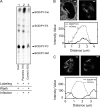Evidence for host cells as the major contributor of lipids in the intravacuolar network of Toxoplasma-infected cells
- PMID: 21685319
- PMCID: PMC3165450
- DOI: 10.1128/EC.00002-11
Evidence for host cells as the major contributor of lipids in the intravacuolar network of Toxoplasma-infected cells
Abstract
The intracellular parasite Toxoplasma gondii develops inside a parasitophorous vacuole (PV) that derives from the host cell plasma membrane during invasion. Previous electron micrograph images have shown that the membrane of this vacuole undergoes an extraordinary remodeling with an extensive network of thin tubules and vesicles, the intravacuolar network (IVN), which fills the lumen of the PV. While dense granule proteins, secreted during and after invasion, are the main factors for the organization and tubulation of the network, little is known about the source of lipids used for this remodeling. By selectively labeling host cell or parasite membranes, we uncovered evidence that strongly supports the host cell as the primary, if not exclusive, source of lipids for parasite IVN remodeling. Fluorescence recovery after photobleaching (FRAP) microscopy experiments revealed that lipids are surprisingly dynamic within the parasitophorous vacuole and are continuously exchanged or replenished by the host cell. The results presented here suggest a new model for development of the parasitophorous vacuole whereby the host provides a continuous stream of lipids to support the growth and maturation of the PVM and IVN.
Figures


Similar articles
-
Toxoplasma gondii Parasitophorous Vacuole Membrane-Associated Dense Granule Proteins Orchestrate Chronic Infection and GRA12 Underpins Resistance to Host Gamma Interferon.mBio. 2019 Jul 2;10(4):e00589-19. doi: 10.1128/mBio.00589-19. mBio. 2019. PMID: 31266861 Free PMC article.
-
Proximity-Labeling Reveals Novel Host and Parasite Proteins at the Toxoplasma Parasitophorous Vacuole Membrane.mBio. 2021 Dec 21;12(6):e0026021. doi: 10.1128/mBio.00260-21. Epub 2021 Nov 9. mBio. 2021. PMID: 34749525 Free PMC article.
-
Intervacuolar transport and unique topology of GRA14, a novel dense granule protein in Toxoplasma gondii.Infect Immun. 2008 Nov;76(11):4865-75. doi: 10.1128/IAI.00782-08. Epub 2008 Sep 2. Infect Immun. 2008. PMID: 18765740 Free PMC article.
-
Biogenesis of and activities at the Toxoplasma gondii parasitophorous vacuole membrane.Subcell Biochem. 2008;47:155-64. doi: 10.1007/978-0-387-78267-6_12. Subcell Biochem. 2008. PMID: 18512349 Review.
-
[Formation and diversity of parasitophorous vacuoles in parasitic protozoa. The Coccidia (Sporozoa, Apicomplexa)].Tsitologiia. 2003;45(4):339-56. Tsitologiia. 2003. PMID: 14520865 Review. Russian.
Cited by
-
Structural, Functional, and Metabolic Alterations in Human Cerebrovascular Endothelial Cells during Toxoplasma gondii Infection and Amelioration by Verapamil In Vitro.Microorganisms. 2020 Sep 10;8(9):1386. doi: 10.3390/microorganisms8091386. Microorganisms. 2020. PMID: 32927732 Free PMC article.
-
Use of Human Neurons Derived via Cellular Reprogramming Methods to Study Host-Parasite Interactions of Toxoplasma gondii in Neurons.Cells. 2017 Sep 23;6(4):32. doi: 10.3390/cells6040032. Cells. 2017. PMID: 28946615 Free PMC article. Review.
-
Sphingolipid synthesis and scavenging in the intracellular apicomplexan parasite, Toxoplasma gondii.Mol Biochem Parasitol. 2013 Jan;187(1):43-51. doi: 10.1016/j.molbiopara.2012.11.007. Epub 2012 Dec 16. Mol Biochem Parasitol. 2013. PMID: 23246819 Free PMC article.
-
Toxoplasma gondii Intravacuolar-Network-Associated Dense Granule Proteins Regulate Maturation of the Cyst Matrix and Cyst Wall.mSphere. 2019 Oct 16;4(5):e00487-19. doi: 10.1128/mSphere.00487-19. mSphere. 2019. PMID: 31619500 Free PMC article.
-
The Toxoplasma gondii dense granule protein TgGRA3 interacts with host Golgi and dysregulates anterograde transport.Biol Open. 2019 Mar 18;8(3):bio039818. doi: 10.1242/bio.039818. Biol Open. 2019. PMID: 30814066 Free PMC article.
References
-
- Bai J., Pagano R. E. 1997. Measurement of spontaneous transfer and transbilayer movement of BODIPY-labeled lipids in lipid vesicles. Biochemistry 36:8840–8848 - PubMed
-
- Charron A. J., Sibley L. D. 2002. Host cells: mobilizable lipid resources for the intracellular parasite Toxoplasma gondii. J. Cell Sci. 115:3049–3059 - PubMed
-
- Coppens I., et al. 2006. Toxoplasma gondii sequesters lysosomes from mammalian hosts in the vacuolar space. Cell 125:261–274 - PubMed
Publication types
MeSH terms
Substances
Grants and funding
LinkOut - more resources
Full Text Sources
Medical
Miscellaneous

